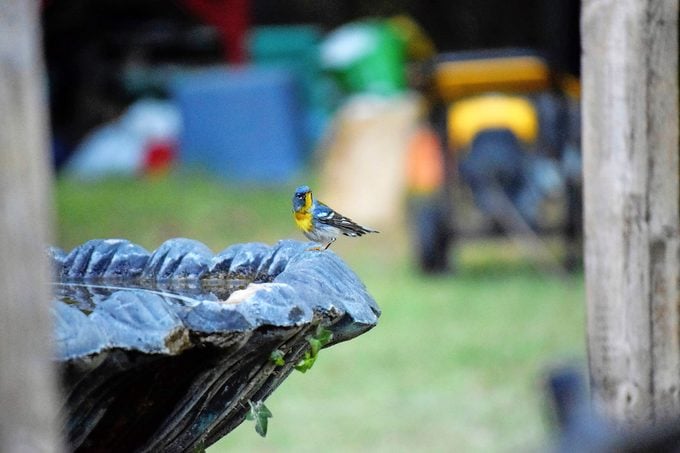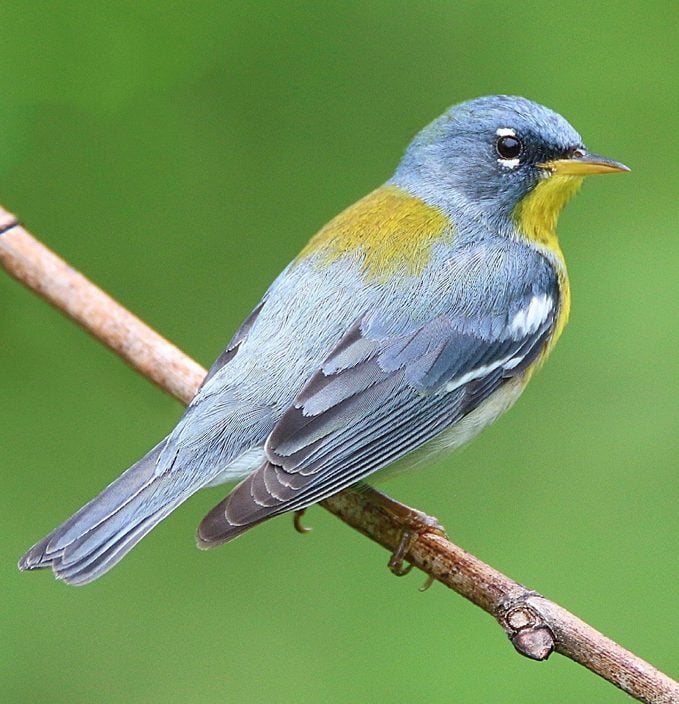How to Identify a Northern Parula
Updated: May 22, 2024
Learn what a northern parula looks like and sounds like. Also find out what these warblers eat and where the birds nest.
On This Page
What Does a Northern Parula Look Like?

“This bird visited us last April. What is it?” asks Birds & Blooms reader Ken Springer.
Birding experts Kenn and Kimberly Kaufman say, “In this photo you’ve captured all the ID marks of a warbler called the northern parula. It has a blue head and shoulders, two white wing bars and a bright yellow throat and chest. We can even see a little of the green triangle on the center of its back.
With its unique name, you might be surprised to find out that this bird is in the warbler family. Other birds you may not realize are warblers include the American redstart, the Northern waterthrush, and the ovenbird.”

Even among warblers, the northern parula is unique. Known for being on the small side in an already small-sized family of birds, the northern parula is perhaps most easily identified by its grayish-blue back and yellow breast. If you’re fortunate enough to look closer, you’d spot white wing bars, a yellow throat patch, and chestnut breast bands on males.
The bird’s white eye ring, too, is a good identifying mark. “It has big, broken eye arcs,” says Dr. Kevin McGowan, senior course developer for the Cornell Lab of Ornithology. “Its eye is accentuated by having this white eyeliner above and below the eye, but not completely encircling it.”
Northern Parula Range and Nests

Northern parula birds travel through most of the eastern half of the United States during breeding and migration season. The gap in their range might look somewhat odd—they stick around in the South and parts of the Midwest, then in the Upper Northeast and in Canada, only passing through the Great Lakes region.
As Kevin says, there’s a good reason for it. He explains that northern parulas build nests in Spanish moss, which is common in the South; farther north, they build nests in Old Man’s Beard, which is similar to Spanish moss.

The places where northern parulas don’t linger are places that have neither Spanish moss nor Old Man’s Beard, and are thus not ideal for the bird to nest.
“There’s a gap because there’s not appropriate moss in that gap range,” Kevin explains. “[The break in their range] is sort of an accident of the fact that the birds are so determined to use this dangling moss and lichen to make nests.”
Nests tend to be built high off of the ground, meaning it would be incredibly difficult to catch a glimpse of one. Females lay anywhere from two to seven eggs.
Learn how to identify a yellow warbler.
Diet: What Does a Northern Parula Eat?

Northern parulas, like most other warblers, eat insects—especially caterpillars. In winter, they’ll occasionally eat berries or seeds. “They’re more of a forest bird, unless you live in the South and have a bunch of Spanish moss in your backyard,” Kevin says. “I have seen them in birdbaths.”
Song and Call

Since northern parulas tend to stay high off the ground, it’s often easier to recognize their song than it is to spot them. Listen for a trill that rises in pitch, followed by a sharp zip!
Bird songs courtesy of the Cornell Lab of Ornithology
About The Experts
Lifelong birder and ornithologist Dr. Kevin McGowan is a senior course developer for the Cornell Lab of Ornithology’s Bird Academy. He earned a Ph.D in biology at the University of South Florida.
Kenn and Kimberly Kaufman are the official birding experts for Birds & Blooms. They are the creators of the Kaufman Field Guide series and they speak and lead birding trips all over the world.
Sources
- Cornell Lab of Ornithology, “Northern Parula“
Why Trust Us
For nearly 30 years, Birds & Blooms, a Trusted Media Brand, has been inspiring readers to have a lifelong love of birding, gardening and nature. We are the #1 bird and garden magazine in North America and a trusted online resource for over 15 million outdoor enthusiasts annually. Our library of thousands of informative articles and how-tos has been written by trusted journalists and fact-checked by bird and garden experts for accuracy. In addition to our staff of experienced gardeners and bird-watchers, we hire individuals who have years of education and hands-on experience with birding, bird feeding, gardening, butterflies, bugs and more. Learn more about Birds & Blooms, our field editor program, and our submission guidelines.























